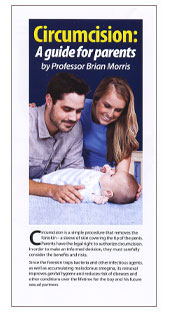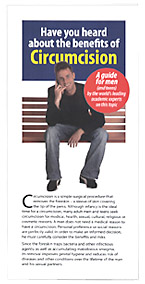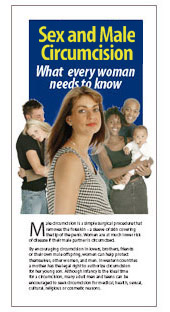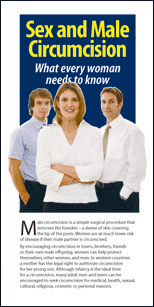Rate of Circumcision in Adults and Newborns
1. Rate of Circumcision in ADULTS
Worldwide approximately 38% of males are circumcised by adulthood as determined by a detailed compilation of data from every country and territory in the world and published in Population Health Metrics [Morris et al. 2016]. This replaces an earlier estimate by the WHO [World Health Organization, 2008a], most of these having been done during childhood, either soon after birth or prior to puberty [Williams & Kapila, 1993].
USA:
Rate is approx. 90% in in the majority white population of males [O'Brien et al., 1995]. About 90% of their circumcisions had been carried out neonatally. A representative, nation-wide survey of all states (National Health and Nutrition Examination Survey (NHANES), 1999-2004, survey) published in 2007 by the Centers for Disease Control (CDC) found that the overall rate in the USA was 79%, with rate varying by race and ethnicity, being 88% in non-Hispanic whites, 73% in blacks, 42% in Mexican-Americans and 50% in others [Xu et al., 2007]. In New York City NYC HANES data show circumcision rate to be 74.5% in US born men and 36.8% in men born elsewhere [McKinney et al., 2008]. Rate was 59.8% in men born 1970-1984, 58.4% for those born 1950-1969, and 49.7% for those born before 1950. It was 71.0% in Whites, 57.9% in Blacks, 54.0% in Asians and 30.0% in Hispanic. Those whose eduction was more than a high school diploma had a rate of 63.7%, a high school diploma 51.9% and less than a high school diploma 37.7%. For men who have sex with men it was 67.7% (being 85.3% for those born in the USA and 35.4% for those born elsewhere) and for heterosexual men was 55.7%.
Prevalence increased, especially in blacks and Hispanics, from the 1940s through the 1970s. Whereas it was 80%, 50% and 34% in Whites, Blacks and Hispanics, respectively, in the 1940s (overall 71%), for those born in the 1970s it had risen to 94%, 91% and 57% in Whites, Blacks and Hispanics, respectively (overall 91%). It then fell in the 1980s to 88%, 81% and 52% for those born in that decade [Xu et al., 2007].
The rate has always been highest in whites at 55% (born before 1890), 44% (1890s), 46% (1900s), 52% (1910s), 61% (1920s), 73% (1930s), 80% (1940s), 90% (1950s), 93% (1960s), 94% (1970s) and 88% (1980s) [Stern & Lachenbruch, 1968; Laumann et al., 1997; Xu et al., 2007].
In San Francisco 56% of 58,598 STI clinic patients examined between 1996 and 2005 were circumcised [Mor et al., 2007]. Rate was Blacks 62%, Whites 60%, Hispanics 42%, Asian or Pacific Islander 48%; gay/bisexual 73%, heterosexual 66% (35% of the cohort were gay/bisexual). Rate rose continuously from 40% for men born in 1920 through to 60% for men born in 1960 and then declined to 43% for men born in 1980 [Mor et al., 2007]. The decline was apparent in all racial group
It should be noted that the San Francisco Bay Area is the heartland of the anti-circumcision movement, being where it started and where its leadership and main activists reside. Clearly this cohort of San Francisco residents differs from the rest of the USA, where circumcision rates are much higher.
In a study of men in Tucson, Arizona, and Tampa, Florida, circumcision rates were 88% in non-Hispanic white men and 66% in Mexican Americans [Nielson et al., 2009]. For American Indians or Alaskan Natives it was 76%. Another study, of men who have sex with men (MSM), in New York City, Philadelphia and Los Angeles, found 74% of Black and 33% of Latino men were circumcised [Millett et al., 2007].
Circumcision rate in US males was, moreover, higher as a function of increase in income [Xu et al., 2007]. (See ‘Socio-sexual aspects’ page for more information.)
The latest data from the Centers for Disease Control and Prevention show that 91% of white American men are circumcised, 76% of Black and 44% of Hispanic [Introcaso et al., 2013] (Prevalence of Circumcision Among Men and Boys) .
UK:
The 2000 British National Survey of Sexual Attitudes and Lifestyle found that 16% of 16-44 year-olds were circumcised, the rate being 20% in those aged 40-44 and 12% in the 16-19 year age group [Dave et al., 2003]. Rates reported in one study were 12.5% for males aged 16-24 years, 15.9% for 25-34 year-olds, and 26.4% for the 35-44 year age group (n = 1,874, 2,111 and 2,049, respectively) [Wellings et al., 1994]. Another found rate was 48% in 305 London males aged 4-93 (av. 42 years of age) [Mallon et al., 2000].
Canada:
Approx. 50% overall, but varies by region and age group (see below in section on rate of infant circumcision).
Australia:
A telephone survey in 2001-02 of 10,173 men aged 16-59 found 59% were circumcised. The rate was 69% for those who were born in Australia [Richters et al., 2006]. However, the rate in those aged 16-20 years was only 32%, leading to public health concerns and a call to increase circumcision [Morris, 2007b]. Most of the men in this survey had been circumcised in infancy. A similar rate of 66% was found amongst 1,427 homosexual men in Sydney in whom circumcision status was confirmed by clinical examination [Templeton et al., 2007].
An earlier report in 1994 found that in adult males in Sydney rate was 62% [Donovan et al., 1994]. And, in a 1995 report, the same group found a 65% circumcision rate [Richters et al., 1995]. In Adelaide rate was 55% [Hart, 1992]. In 2006 there were 1965 claims for circumcision of males aged over 10 by a specialist and 731 by a general practitioner [Medicare, 2007a]. Claims rose 5.4% over the 5 years to 2006. These figures are best for monitoring trends. The actual numbers would have been higher than these, probably very much higher.
New Zealand:
The circumcision rate in 1037 men aged 26 who were born in 1972–1973 in Dunedin was 40% [Dickson et al., 2005], and in a smaller study in Christchurch was 30% [Fergusson et al., 2006].
SUB-SAHARAN AFRICA:
Overall rate is 62% [Drain et al., 2004]. Circumcision rate varies markedly between tribes that do and do not circumcise. Circumcision is usually done later and rate amongst males over 15 years of age is 8% in Swaziland, 10% in Zimbabwe, 11% in Botswana, 12% in Malawi, 13% in Zambia, 14% in Uganda, 21% in Namibia, 25% in Uganda, 35% in South Africa, and 70% in Tanzania, 83% in Kenya, 85% in Ghana, 90% in Nigeria, 90% in Angola, 90% in the Democratic Republic of Congo, and 92% in Ethiopia (reviewed in[World, 2008b; de Bruyn et al., 2010]).
ASIA:
Generally: 8 out of 27 South and Southeast Asian countries have high rates of circumcision [Gopal, 2009].
Pakistan, Bangladesh, Indonesia, Malaysia:
Very common owing to majority Muslim population in each [Gopal, 2009].
Philippines: 93% [Castellsague et al., 2005]. Of these, 42% have their circumcision before the age of 10, 52% have it done between 10 and 14, and for 5% it is between 15 and 18 [Gopal, 2009].
South Korea: 90-95% (at age 18, the average age for circumcision being 12 years) [Pang & Kim, 2002; Gopal, 2009]. Applies to majority Christian population, not just Muslims.
Thailand: 13% [Castellsague et al., 2005].
China: Xinjiang Uyghur Autonomous Region and Yunnan Province - 19.9% [Sullivan et al., 2009]. Boys aged 11 to 18 in Chongqing – 17% [Yang et al., 2009]. Four regions of China, 2.7% amongst boys aged 3-23 [Ben et al., 2008].
Taiwan: 9% (age 13) [Hsieh et al., 2006; Ko et al., 2007].
Cambodia: Low [Gopal, 2009].
Papua New Guinea: Low [Gopal, 2009].
Pacific Islands in general: High (most between 6 and 10 years of age) [Afsari et al., 2002].
Maoris in New Zealand: From high rates in their traditional ancestors, rate has decreased to low levels in recent times, not helped by a Health System in New Zealand that makes it difficult to get a circumcision.
EUROPE:
Spain: 2% [Castellsague et al., 2005].
Slovenia: 4.5% overall, being 7% for Catholic, 92% Muslim, 0% Orthodox, Evangelical, other religious, and 7% (no religious affiliation) [Klavs & Hamers, 2007].
Finland: 1-2% (according to the Finish Ministry of Health, but 7% of Finish males need a circumcision for medical problems [Schoen, 2007e]).
Denmark: 1.6% (age 15) [Frisch et al., 1995]
CENTRAL AND SOUTH AMERICA:
Mexico: 10-30%, depending on the population [Lajous & Mueller, 2006]
Brazil & Columbia: Columbia and Sao Paulo, Brazil 7% [Castellsague et al., 2005]; Rio de Janeiro, Brazil 13% [Périssé et al., 2009].
![]()
2. Rate of Circumcision in NEWBORNS
RECORDED incidence of newborn circumcision in different countries:
USA:
In the USA the rate of infant circumcision has always been high. In 2002 the number of infants circumcised before discharge from the birth hospital was 1.2 million [Kozak et al., 2002], as compared with 142,000 subsequently (being 93,000 up to age 15 and 49,000 after age 15) [Owings & Kozak, 1998]. In a 2008 report, hospital discharge data in Maryland found 75.3% of 96,457 male infants were circumcised after birth and survey data from 4,273 mothers showed a rate of 82.3% [Cheng et al., 2008]. Rate was lower amongst Hispanic and Asian infants and thus higher in non-Hispanic White and Black infants.
In earlier surveys, rates have been recorded by the CDC's National Center for Health Statistics (NCHS) [National, 2003]. Since only those circumcisions recorded are included in these statistics, the data are under-estimates [Schoen, 2006b], and are more useful for determining trends rather than absolute rates. The statement of an overall rate of 65.3% is thus much lower than the true rate [Schoen, 2006b].
Despite being underestimates some trends can be noted in NCHS data. For Whites there was no change over the years studied (65.8 vs 65.5%). For Blacks it rose from 57.9% to 64.4%. The rates recorded in the north-east region were steady at 70%, while rates rose in the mid-west (80%) and South (70%). For the western region rates have been falling due to the influx of Hispanics (50% of all births, so diluting out the overall rate in California to 35%). Overall the statistics show an increase in circumcision rate for Non-Hispanic Whites. In the West individual hospital data have shown, moreover, the rate for non-Hispanic Whites is in fact 75-80%. Interestingly, for the next generation of Hispanics, 29% of boys are circumcised (San Francisco General Hospital data).
Importantly, as noted, the actual rates are higher than indicated by these data since the latter represent only the numbers reported, whereas not all are: under-reporting being more than 10% in one large study [Gelbaum, 1992]. Even when they are supposed to be, they are often not listed on the medical record face sheet used in NCHS surveys, so that after the oversights were corrected in one study, infant circumcision rate increased from 75% to 89% [O'Brien et al., 1995], i.e., is consistent with the 2006 report by the CDC [Xu et al., 2006]. The true neonatal circumcision rate for the 1980s is probably 82% [Waskett, 2007].
The rates thus differ notably for different ethnic groups. Whites of Anglo-Celtic derivation have high rates, as do Blacks. In Hispanics the rate is quite low, circumcision not being a part of their culture. Thus high Hispanic populations will contribute to an overall lower rate for a particular region. In La Canada Hospital, Los Angeles, in which 71% of patients are upper-income whites, 83% of parents chose circumcision for their sons [Adler et al., 2001]. In comparison the Children's Hospital, Los Angeles, which serves primarily Hispanics, reported only 16% being circumcised [Adler et al., 2001]. The lower rates amongst non-Jewish European immigrants also contributes to a reduction in the overall rate for the entire USA. Interestingly, in this study, no difference has been found between families with and without private health insurance to cover the costs [Quayle et al., 2003].
Between 1988 and 2000 the rate of circumcision of NEWBORNS BEFORE HOSPITAL DISCHARGE following birth increased 6.8% per year in the USA [Nelson et al., 2005]. This analysis involved 4,657,402 male newborns in whom rate was seen to rise from 48.3% to 61.1%. The elevation was considered to be in response to the increased recognition of the medical benefits of circumcision [Nelson et al., 2005]. Rate was greater for those privately insured, of a higher socio-economic status, in better health, and of Black race. Increases were, however, seen in every racial group, including Hispanics. The increase in Blacks made their rate catch-up to that in Whites. Rate was higher in the South, Northeast or Midwest location (P < 0.0001 for all of these) [National, 2003]. In the USA, most circumcisions are performed during the newborn hospitalization [Wiswell et al., 1993]. Of course circumcisions after discharge from hospital would increase the overall rate even more. This, together with inclusion of circumcisions not recorded by hospitals, would then account for the 80-90% rate in seen in adults in majority groups in the US population.
Canada:
The Canadian Institute for Health Information reports a rate of 20% for the mid-1990s declining to 9% in 2005. The Provincial Ministries of Health give rates of 51-67% in 1970, steadily declining to 18-23% by 2003 in Alberta, British Columbia, Manitoba and Saskatchewan. To illustrate the variation between different regions, even within the same province, the Ontario Ministry of Health and Statistics Canada, and Institute for Clinical Evaluative Sciences, have reported rates between different districts ranging from 2% to 70%, with a mean of around 50%. Then in 2009, the Public Health Agency of Canada reported a rate of circumcision of male babies of 31.9% for Canada overall for 2006-2007 [Canada, 2009]. Rate was 44.3% in Alberta, 43.7% in Ontario, 39.2% in Prince Edward Island, 35.6% in Saskatchewan, 31.6% in Manitoba, 30.2% in British Columbia, 18.0% in New Brunswick, 12.3% in Quebec, 9.7% in Northwest Territories, 6.8% in Nova Scotia, and lack of reliable information for Nunavut, Newfoundland and Labrador.
Australia:
Medicare statistics [O'Donnell, 2004], which relate only to rebate claims for circumcision, and are thus underestimates, show a rate for circumcision in 2004 in infants of 17% Australia-wide. The actual rate would therefore be somewhere between 17% and the 32% figure above for males aged 16-20. The Medicare data are nevertheless useful for monitoring trends. For boys aged less than 6 months the Medicare data show a rise in rate over the decade from 10.6% in 1994 to 12.7% in 2004 [O'Donnell, 2004]. In the largest state, New South Wales, the rate rose from 11.3% to 16.3%. In the next biggest state, Queensland, it increased from 16.3% to a steady rate of 19.5–20.8% until 2004 [O'Donnell, 2004]. In Brisbane approx. 50% of infants get circumcised today (Dr Terry Russell, personal communication).
Medicare claims for infant (< 6 month old) circumcisions show a rise over the years 2003 to 2006 as follows: 16,138, 16,386, 16,337, 17,176, 17,778 [Medicare, 2007a], i.e., a 10.2% increase. Claims were highest in New South Wales (8323), followed by Queensland (5231), then Victoria (1994). For ages 0.5-10 y, there were 3511 claims in 2006.
Again, to emphasize, the actual number circumcised is upwards of this lower limit. The data do not include circumcisions paid for privately or covered by Veterans insurance, nor do they cover circumcisions done by hospital doctors to public patients in public hospitals. In this regard, different states have different public hospital policies, it was until recently easier to get a public patient circumcised by a hospital doctor in a public hospital in Western Australia, for example. This could explain the lower reported Medicare rates in this state and others, such as Victoria, especially when one compares rates in the neighboring states of South Australia and New South Wales. In 2006-2007 governments in the southern states stopped elective circumcisions in their public hospitals, which meant all had to turn to the expertise of the private sector and bear the cost. This has disadvantaged the poor.
The influence of ritual circumcisions in Jews would be small as the Australian Jewish community is less than 0.4% of the population. Another group in which the males are circumcised are the Muslims, but these make up only approx. 1% of Australians.
New Zealand:
For boys born in the early 1970s the rate was 40% (see above in adult section), but has since declined.
United Kingdom:
Newborn circumcision was dropped by the British NHS in 1949 in response to the famous physician Douglas Gairdner [Gairdner, 1949] who was opposed to it, noting 16 deaths annually, although these were from the general anesthetics employed back then, NOT the circumcision itself. In England, rate at age 15 was reported in 1989 as 7% [Rickwood & Walker, 1989] and in 2000 as 4% [Rickwood et al., 2000]. Rates in older males in the UK are higher (see above). In Scotland figures from the NHS, which offers circumcision routinely, give an annual rate in 0-13 year-olds of 4% in 2000 [Quaba & MacKinlay, 2004]. Data from the Hospital Episodes Statistics database for admissions to NHS hospitals in England with a medical indication for circumcision (90% for phimosis, 8% recurrent balanitis, 2% other reasons) noted 2.6 recorded circumcisions per 1000 in 1997 and 2.1 per 1000 from 2000 to 2003 [Cathcart et al., 2006]. Of these, 36% were in boys aged <5, 45% in those 5-9 years old, and 19% in the 10-14 year age group. Note that these data refer to medical, not nonmedical, circumcisions and apply only to NHS hospitals, not private hospitals or clinics. In the year Apr 2003 to Mar 2004 11,000 boys under age 14 were circumcised on the NHS in England [Department, 2005]. Concerns have been raised about “community circumcisions’ and inequality of healthcare provision in the UK, noting the commitment by Scotland at least to a funded ritual circumcision service within the hopital-based setting [Atkin et al., 2009].
Other regions:
In these regions the rates vary according to religion and culture, with rates approaching 100% amongst Muslims, Jews and certain tribes, and low rates amongst some other groups and nations. Hindus for example do not usually circumcise. For Christians, advocacy differs amongst different groups or denominations. For Jews and some Christians the circumcision is performed in infancy (day 8 in Jews), but in Muslims it can be done at any age during childhood. For others it can be a ‘rite of passage’ to manhood, being performed around the time of puberty.
Scandanavia: 2% [Frisch et al., 1995].
Europe, Russia, China, Japan: Low (no published studies). In Japan, immediate and definitive reasons for circumcision for medical problems are the same as in other countries [Hayashi et al., 2009]. Its benefits in disease prevention are said to be recognized in medical circles in Japan.
South Korea: 5-10% (but rises to over 90% by age 18, the average age for circumcision being 12 years) [Pang & Kim, 2002]
Taiwan: 7% by age 7 and 9% by age 13 [Hsieh et al., 2006; Ko et al., 2007]
RELIGIONS:
Judaism: over 95%
Islam: 15% (rising to over 95% by adulthood; av age 6) [Sahin et al., 2003]



